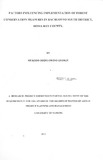| dc.description.abstract | This study was to establish how factors influence implementation of forest conservation measures in Rachuonyo South district, Homa-bay County. Forest covers around 30% of the world's land area where it provides food, wood medicinal plants and multiple other goods and services for hundreds of millions of people. Despite these advantages,plunder of Kenya forest has continued over the years even with pleas to conserve them. Biodiversity is a term that was developed as a means of describing the variety of life at a time when t;oncem was increasing about the loss of such variety.
This study was out to achieve the following specific objectives; the effect of level of income among the rural population living next to forests, government funds allocated for forest conservation to the district, government policies on forest conservation, level of education of the adjacent population to the forest as well as level of awareness of these population of the importance of forest, and social cultural factors and their influences on implementation of conservation measures in Kasipul division. The study findings are expected to be beneficial to the government in establishment of proper policies on implementation of forest conservation measures in Rachuonyo south district, it would also realize the problems facing rural Kenya population in terms of awareness of the importance of trees. The study was based on conservation theory.
Conceptual framework was used to show the relationship between dependent and independent variables. The study adopted a descriptive survey design. It targeted 40 villages located within a radius of 10 kilometers around Wire and Kodera forests. A sample of 10% of the target population was taken. Structured questionnaire and interview schedules were used to collect information from respondents. Content validity was ascertained through expert judgement while reliability was established through test retest. Questionnaires were hand delivered and picked by the researcher who also conducted interviews to forest officers. Data analysis was done by both qualitative and quantitative techniques.
Quantitative data was analysed by use of simple descriptive statistics that is, frequencies, percentages and averages. The qualitative data was analysed and reported in narrative form. Data analysis, presentation and interpretation was done through the use of tables and a summary, conclusion and recommendation of the study done. The findings showed that poverty level of education were the major cause of poor implementation of forest conservation measures. Others were inadequate financing, policies as well as socoi-cultural factors. In conclusion, it was found that level of income and education remain the major challenges to implementation of forest conservation measures. The study recommended. that poverty eradication strategies and youth empowerment programs should be enhanced. | en_US |

